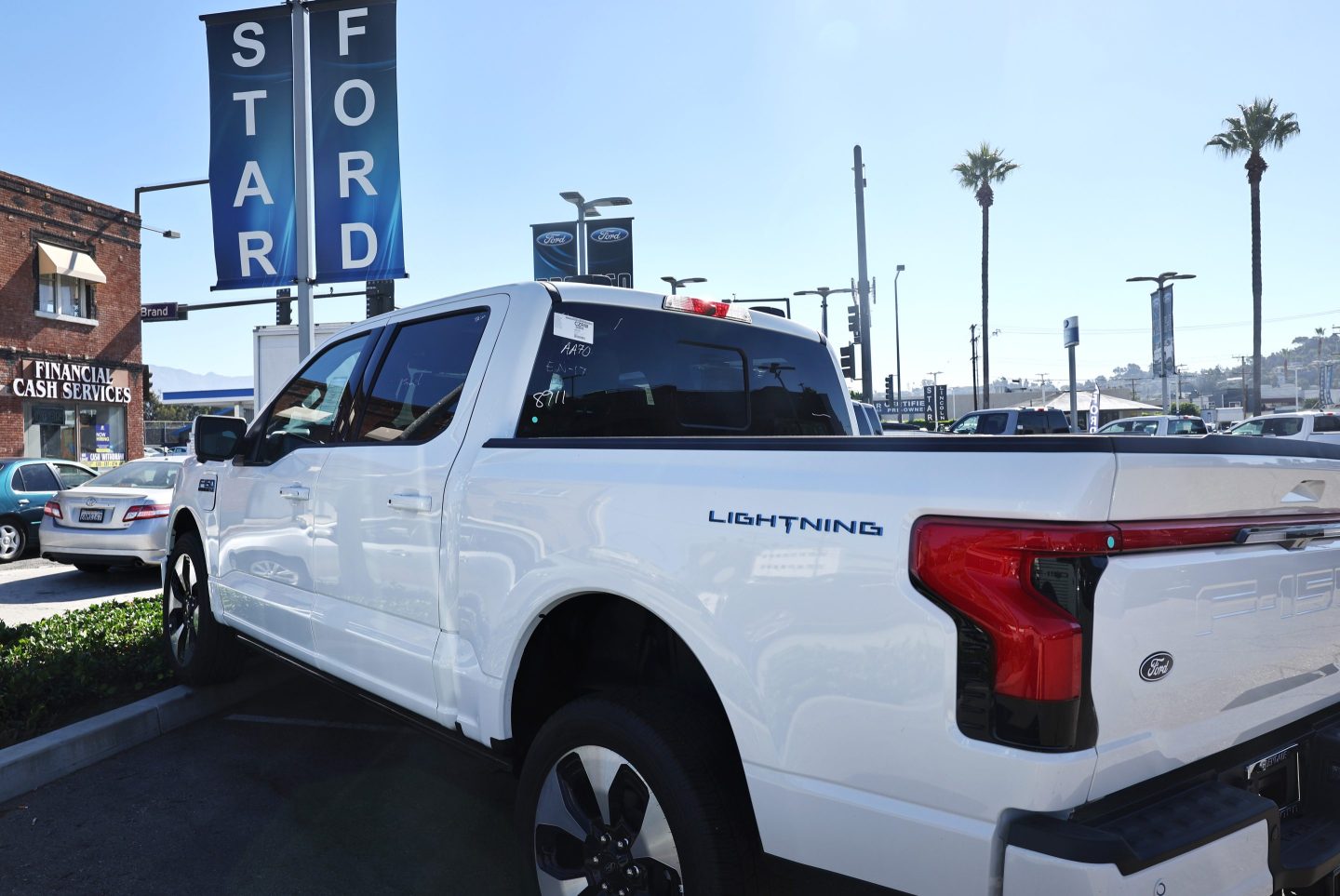Just a year ago, Jesse Acosta fell in love with the smoothness and speed of his new Ford F-150 Lightning, an electric version of Ford’s best-selling truck. Now, he wants to get rid of it.
The Lightning’s stated range is 230 miles (370 kilometers), but reality never seems to reflect the conditions necessary to achieve that. As soon as he starts climbing through the mountains on the 130-mile trip from Fresno to his parents’ place in Capitola, the load on the battery depletes the range until it’s down to 40 miles of power. Though he’s never been stranded, the fear of running out of juice spoils every trip. “I’ve had it for a year and the one thing you can’t discount is just how nerve-racking it is,” Acosta, 41, said.
The EV market has turned as mainstream car buyers balk at high prices and spotty charging infrastructure. While the global slowdown hit every automaker, it’s left Ford Motor Co. especially vulnerable because the company has no new EV models coming for more than two years. The manufacturer abandoned plans to build 2 million electric vehicles by 2026, along with any near-term hope of earning a return on the tens of billions of dollars it’s poured into developing battery-powered models.
Rivals have begun rolling out their own electric models — including innovative, lower-cost options — and it will take years to execute on a strategy that could make Ford more competitive. President Donald Trump may make that task more difficult. He’s threatened to impose 25% tariffs on goods from Mexico, where Ford builds its Mustang Mach-E, and to strike a $7,500 consumer tax credit that helps dealers sell battery-powered cars.
“Ford has stalled,” said David Whiston, an analyst with Morningstar Inc., who rates Ford the equivalent of a buy. “For the next couple years, it’s probably going to be pretty ugly for them on the EV side.” As Ford’s EV losses reached a record last year, the stock fell almost 19%. The shares are flat so far this year as Trump’s tariff threats against Mexico and Canada have roiled auto stocks.
Ford is expected to give a forecast on its EV losses and overall business when it posts fourth-quarter results on Wednesday.
The New Strategy
Chief Executive Officer Jim Farley made what he called a “tremendous pivot” in August when he scrapped plans for a big, three-row electric sport utility vehicle — a model he earlier said would sidestep competition from Tesla Inc. and top Chinese EV maker BYD Co.
Ford determined it had no path to profitability because it would have to be high-priced to cover the cost of its big battery. By then, increasingly reluctant American EV buyers had shown “no willingness to pay a premium” for a battery-powered car over a traditional gas-fueled model, he said in an interview at the time. The move cost Ford around $1.9 billion.
“We are working very hard on EV affordability, because I think that will be the catalyst for much wider adoption,” Bill Ford, the company’s executive chair and great-grandson of founder Henry Ford, told reporters at the Detroit auto show on Jan. 9.
Farley now has the company’s electric ambitions riding on two key plays. To better compete on price, a former Tesla executive and a small “skunkworks” team of Ford engineers and designers in California are developing a line of small EVs starting under $30,000. To ease drivers’ charging anxieties, Farley revealed in early January that Ford is engineering the base technology for extended-range electric vehicles, or EREVs. Those plug-in hybrids can lengthen a vehicle’s driving distance to as much as 700 miles by adding a small internal combustion engine that doesn’t drive the wheels and only acts as an onboard generator to recharge the battery.
EREVs have become very popular in China, the world’s largest market for battery-powered cars, and Farley was wowed by the technology during a visit there with his executives last spring. Ford plans to offer EREV versions of its sport utility vehicles, crossover models and its big Super Duty pickup, its most popular and profitable vehicles, according to people familiar with its plans.
No automakers currently offer EREVs for sale in the US, but that will change soon. Chrysler parent Stellantis NV will be the first to offer one later this year with its Ram 1500 Ramcharger. Volkswagen AG’s new battery-powered Scout line of SUVs and trucks is slated to debut EREV versions in 2027.
The problem is, neither Ford’s lower-cost EVs nor its EREVs will arrive before 2027, according to the people with knowledge of its plans. That leaves the automaker with a pipeline empty of new offerings during a period when Ford Vice Chair John Lawler says 150 new plug-in models will flood the US market by 2026. General Motors Co. already overtook Ford in EV sales in the second half of 2024, and investors impressed with its more affordable approach to electrification sent GM’s shares up 48% last year. Tesla’s Cybertruck is now outselling the Lightning.
But First, Survival
In the short term, Ford is stuck with an aging EV lineup that it’s struggling to make more competitive by slashing the cost to build them, repeatedly cutting prices and pausing production to reduce inventory. Its Lightning factory in Michigan was shut for almost two months at the end of last year. That came shortly after Ford began giving away $2,000 home chargers to stimulate sales, which helped finally move the metal, as its EV sales rose 16% in the final three months of the year.
Before that incentive began Oct. 1, inventory of the Lightning and the electric Mustang Mach-E SUV was sitting on dealer lots for more than three months on average, almost 20% longer than EVs took to sell industrywide, according to auto-market researcher Edmunds.
“It’s going to be two years out before we see something that’s affordable from Ford. I mean, how much cost can they strip out of a Mach-E to try to push that lower in the price range?” said Ivan Drury, a senior analyst for Edmunds. “The tables have turned against them.”
Ford is hoping it can lure car buyers in the meantime by adding new features to its existing EVs, such as a sporty rally version of the Mach-E it rolled out last year. A heat pump it’s adding this year will extend battery life in cold climates, Marin Gjaja, head of Ford’s EV unit Model e, said in an interview.
“We are always looking for improvements and getting unnecessary costs out,” Gjaja said. “The rate of competitive change means we can’t sit still, we’ve got to keep grinding on this.”
Ford has said it’ll reduce overall spending on EVs by at least $12 billion and shift some of those resources to money-making gas-powered models. The company lost $35,000 on every electric vehicle it sold in the third quarter and racked up around $5 billion in losses at its EV unit in 2024. Despite belt-tightening, the losses are expected to be similar this year. Morgan Stanley analyst Adam Jonas estimates $4.8 billion in EV losses for 2025.
Ford shares have fallen by more than 60% since the company’s market value briefly topped $100 billion in January 2022 as the market cheered on its aggressive EV strategy.
Read more from Fortune
–UnitedHealth falls after U.S. opens probe of Medicare billing
–Her 12-year-old son has autism and epilepsy and was kicked out of class.
–NYC’s most elite private high schools will cost nearly $70,000 this fall
–Tesla recalls more than 375,000 vehicles due to power steering issue
–Nissan shares surge on report Japan group may seek Tesla deal
‘Difficult Decisions’
Ford is expected to provide more details about its EV strategy at an investor meeting in the first half of the year. For now, the company won’t say when it expects to begin generating a return on the small fortune it’s plowed into EVs.
Jefferies cited uncertainty about Ford’s EV plan as one of the reasons it downgraded the stock to “underperform” in December. Analyst Philippe Houchois wrote that the automaker faces “difficult decisions” on a yet-to-be announced electrification strategy, “which we suspect may be centered around range-extenders (EREV).”
Ford already has made difficult decisions to pull back. Last year, it exited an $872 million joint-venture factory under construction in Canada to produce cathode active material used in EV batteries. Ford was to have a 25% stake in the project with South Korean battery firms SK On Co. and EcoPro BM Co.
The automaker also is scaling back Blue Oval City, the massive manufacturing complex it is building in rural Stanton, Tennessee, near Memphis. That facility now will produce fewer than 100,000 electric F-Series trucks annually when it comes online in 2027, instead of the 300,000 previously planned, according to people familiar with the details. In the future, it could be modified to build EREVs, Gjaja said. “We have flexibility to create plants that can do different things,” he said.
Gjaja said Ford expects to command premium prices for the next-generation electric F-Series pickup, which many drivers use as a work truck. He says the company is counting on unspecified breakthroughs in battery technology to lower costs and make the model profitable.
“That customer really wants that larger battery,” Gjaja said. “They want the range, they want the power for towing. And so there’s much more of a willingness to pay for that.”
Acosta, the Lightning owner, isn’t so willing to pay. He needs a truck that can reliably transport the clothing accessories his wife sells through her retail business at street fairs. That’s why he’s anxious to replace his battery-powered pickup with a gas-guzzling Ford Super Duty.
“We are looking at getting a trailer for my wife’s business and there’s just no way because that would cut the range in half,” he said. “I absolutely would never go full EV again.”












